________________
INTRODUCTION
lxxix became a Muni engaged in tapas or yoga. This Vrishabha is supposed to be the founder of the doctrine of ahimsa that it is wrong to inflict pain on any living thing on any account even in the name of religion or God. From this Vrishabha the tradıtion speaks of a succession of Jaina prophets ending with the last and the twenty-fourth Mahavira Vardhamana an elder contemporary of Gautama Buddha The date of His nirvana is fairly well determined to be 527 B.C. The Jaina tradition associated his immediate predecessor Parswanatha with Kası. He was the son of the King of Kası, whose name was Viswasena. The interval between Parswa and Mahavira is 250 years and this would place him about 777 BC. This date is recognised to be fairly accurate and the personality of Parswa is accepted to be quite historical The fact we have to notice in connection with this Jaina tradition is this. Of the 24 Jinas nearly 20 ate associated with the Ikshavaku house and all of them are connected with the Royal houses of Kası, Kosala, Videha and Magadha.
Throughout the sacred Jasna writings the country of Videha is referred to as a sacred land, nithyapunyabhumi, where the Dharma never dies-- Dharma referring to the doctrine of Ahimsa. The importance of Videha, we shall know in another connection also The Upanishadic thought mainly centred round Janaka of Videha and Yagnavalkya also of Videha. Perhaps we have to make a slight distinction between Eastern Videha and Western Videha. The portion bordering on Magadha, what is known as Purya Videha, evidently retained the anti-sacrificial culture whereas the north-west part of Janaka's country finally accepted a sort of compromise between these sacrificial ritualism and the antısacrificial protestantism. The same importance of the Ikshavaku house we find in Buddhistic literature. The very first chapter of Rockhill's life of Buddha contains an account of the life of the Sakyas clan to which Gautama Buddha belongs. In this account we find the Sakya clan traced to the house of the Ikshavakus. This evidently implies the general belief in those days, that to trace their lineage to the Ikshavaku house was considered to be a proud distinction among the Kshatriya clans. Such a distinction could be claimed by this Ikshavaku house




